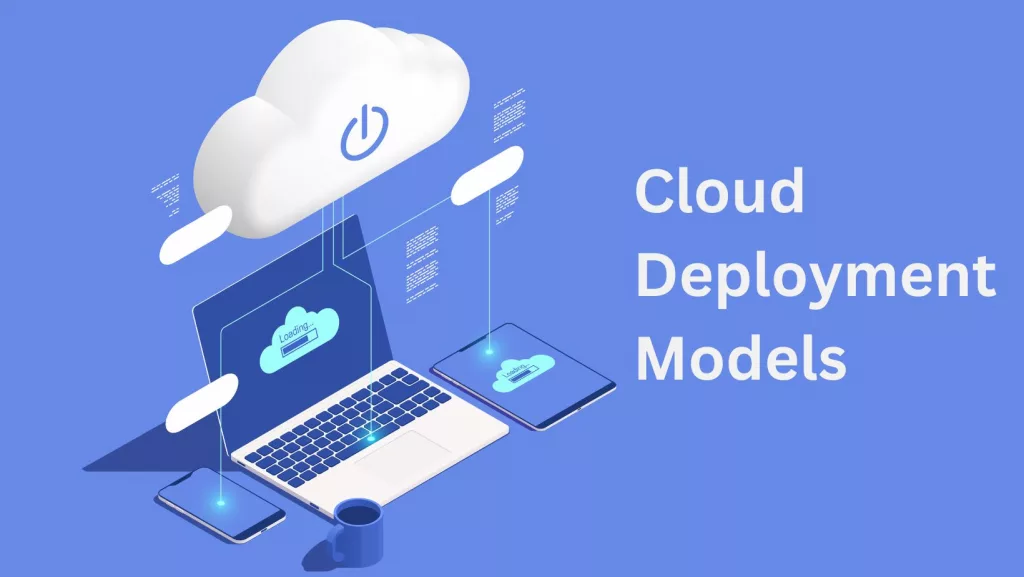Companies are progressively embracing cloud computing to fulfill their computational requirements in the swiftly changing realm of technology. This technology offers a scalable and adaptable solution for storing, processing, and retrieving data through the Internet.
One crucial aspect of adopting cloud computing is selecting the appropriate deployment model. Cloud deployment models define how and where the infrastructure, applications, and services are hosted. This article will explore the various cloud deployment models and discuss their advantages, disadvantages, and considerations for choosing the suitable model for your business. But first, let’s understand the basics.

Simply put, a cloud deployment model is like a blueprint for your cloud setup. It outlines who’s in charge, how much space you get, and what you can do with it. Picking a deployment model isn’t just about tech specs but control and location. Your choice affects who calls the shots, owns the setup, and handles the workload specifics. Choosing the right cloud deployment involves considering cost, privacy, and user requirements.
Major cloud service providers also present various tools and services within their cloud service models. These offerings help efficiently handle architecture, computing, and infrastructure tailored to meet specific business requirements.
To identify the optimal fit for your business, consider several key aspects:
Before making a decision, carefully consider the advantages and disadvantages of each model. It’s akin to selecting the appropriate tool for a task – ensure it seamlessly aligns with your business needs.
Here are the top 3 deployment models you can use for business efficiency:
In simple terms, the public cloud deployment model is like a shared playground in the digital world. Big-name service providers build and look after the space, and then businesses and the public get to use it for creating and storing data.
Here’s the deal: you don’t have to worry about managing the playground; that’s the service provider’s job. All the tech stuff is kept in their place. What’s great is that you have the flexibility to utilize the playground to the extent you require, and you’re charged solely for the resources you actually use. They are most popular in the cloud world, with 91% of businesses using them for about 41% of their workload. Amazon’s Elastic Compute Cloud (EC2) is like the superstar of this public cloud party, leading the pack.
Advantages of Public Cloud:
Disadvantages of the Public Cloud:
Key Considerations:
Think of public and private clouds as two sides of the same coin. While they might seem totally different, they actually share a similar structure and use cloud resources in much the same way.
Public clouds are like the neighborhood park, open to everyone. On the other hand, private clouds are more like private gardens accessible only to one particular business. This exclusive setup can either be in the business’s backyard or taken care of by another company. No matter where it lives, in your space or someone else’s, a private cloud keeps its hardware and software locked away, sharing them only with the owner on their private network.
Private Cloud Advantages:
Private Cloud Disadvantages:
Key Considerations:
Think of the hybrid cloud like a tech superhero – taking the best features from public, private, and community clouds to create a powerhouse of performance, flexibility, and economic sense.
What’s cool is you get to pick and choose what parts from each cloud model suit your business. Almost 7 out of 10 businesses using cloud tech go for the hybrid model. It’s like having a menu that you can customize based on what your business craves.
So, if your work involves handling a mix of super-sensitive private data and regular public info, the hybrid cloud is your go-to sidekick. It lets you invest where it matters most, saving resources for stuff meant for the public eye. It’s like having the best of all cloud services right at your fingertips!
Hybrid Cloud Advantages:
Hybrid Cloud Disadvantages:
Key Considerations:
In summary, choosing a suitable cloud deployment model is important for businesses in the ever-changing technological landscape. Options like public, private, and hybrid clouds present unique advantages and considerations. Decisions should be informed by business objectives, technical requirements, and budget constraints, focusing on optimizing efficiency, security, and innovation. Consulting with cloud consulting services can further enhance the decision-making process, providing valuable insights and expertise to ensure the optimal utilization of cloud computing resources.